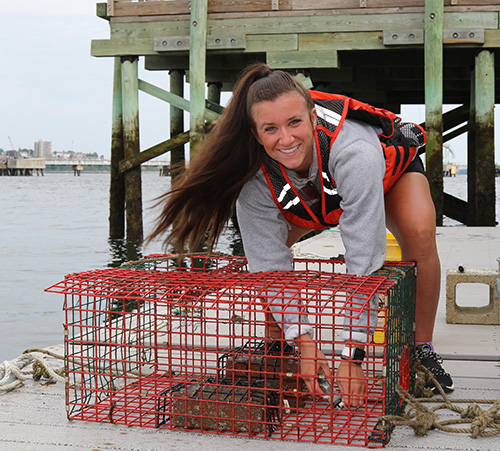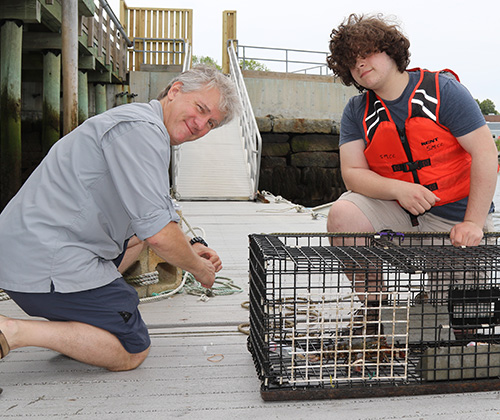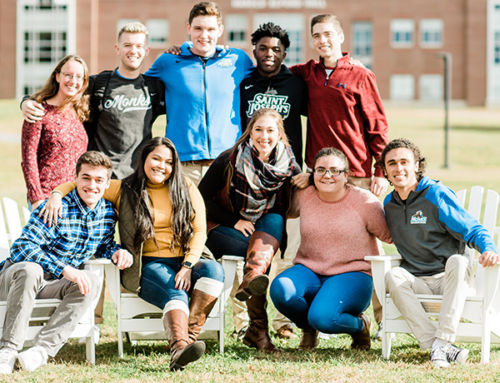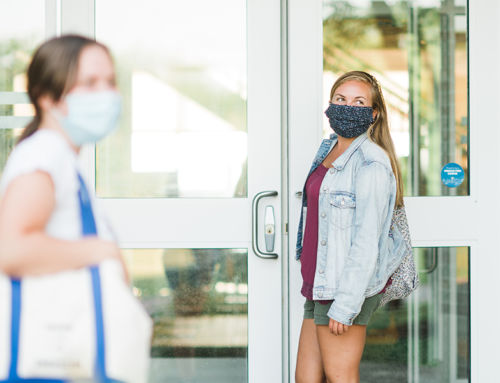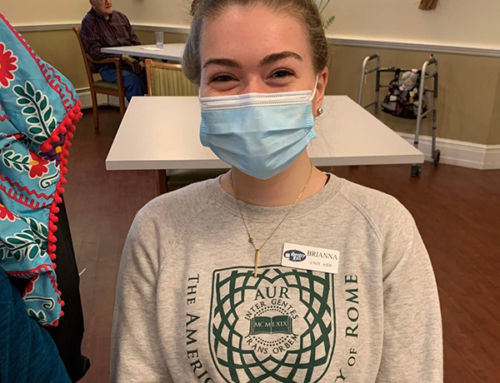Grants from John Sage Foundation and Maine SeaGrant Make it Possible for Students and Faculty from Saint Joseph’s College and Southern Maine Community College To Test Alternative Lobster Bait
By MaKenzie Copp ′20, double majoring in English and Writing and Publishing
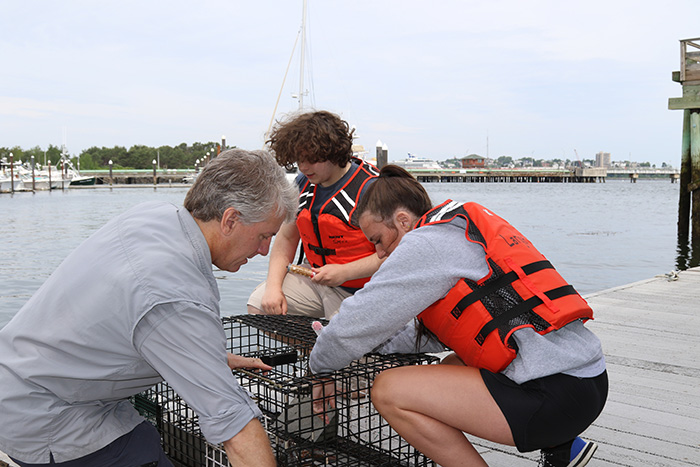
Dr. Steven Jury, students Bailey Gryskwicz ’20 of Saint Joseph’s, and David Glass of Southern Maine Community College (SMCC), configuring their modified lobster trap at SMCC.
Over the summer, a John Sage Foundation grant made it possible for Saint Joseph’s College faculty and students to conduct research with the potential to help solve two problems facing marine ecosystems on the Maine coast. Herring, the traditional lobster bait, is now in limited supply for lobster fishers, and invasive green crabs, which threaten shellfish like clams and oysters, are unfortunately increasing. In conjunction with Maine SeaGrant, which also funded project development, the Sage Foundation grant allowed SJC and SMCC students and faculty to design and test an experiment using alternative lobster baits and physical trials.
The project was led by Saint Joseph’s Assistant Professor of Biology, Dr. Steven Jury, alongside Southern Maine Community College Marine Science professor Brian Tarbox. They worked with two students interns, Bailey Gryskwicz, a SJC Senior Medical Biology/ Pre-Dental major; and David Glass, a SMCC Sophomore Marine Science major. Together, they worked to produce smart, sustainable solutions to a key problems facing Maine’s lobster industry and aquatic ecosystems.
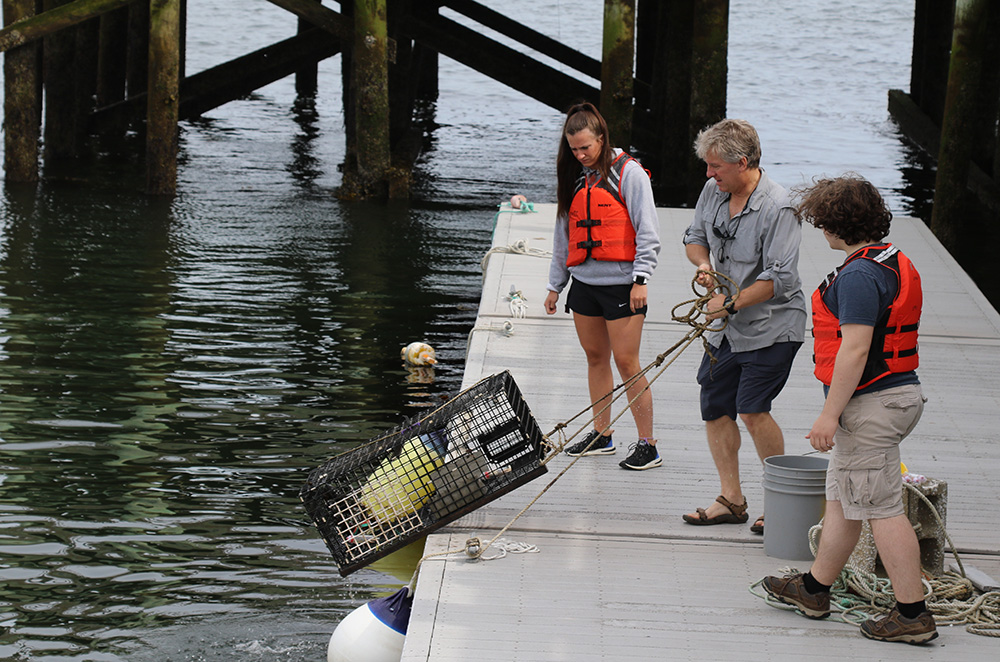
Dr. Steven Jury, Bailey Gryskwicz, and David Glass retrieving their trap from the water.
This project was to produce an effective alternative lobster bait using the invasive green crab. This would help lobstermen by providing an alternative bait to herring, which is increasingly hard to obtain, and also address the threat posed by the growing number of invasive green crabs found in Maine waters. In recent years, there has been a concentrated effort by marine scientists to develop depletion methods for these green crabs. Dr. Steven Jury explained that during the Green Crab Working Summit in June of 2018, experts in the field spent two days in Portland, Maine, discussing the species, their effects on the ecosystem, and potential products for which the crab could be used, including softshell crabs for humans, compost and bait for lobsters. Local chefs even tried their hand at cooking the crabs in an array of different ways, exploring whether or not they could produce a culinary market for the invasive species. The problems that these crabs pose, combined with regulations set to protect an overfished herring population, provided a unique opportunity for the SJC/SMCC team. If successful, their work would provide lobstermen with an effective alternative to herring while also providing an incentive to develop a green crab fishery.
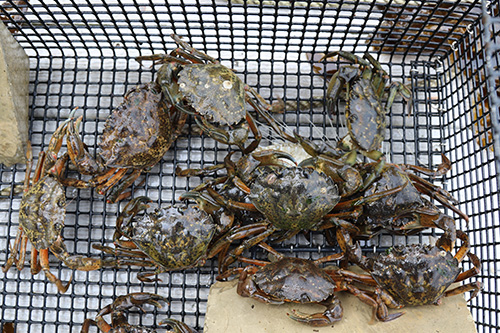
Invasive green crabs
Dr. Jury explained that in order to create the green crab bait they needed to understand which part, or parts, of the crab might be attractive to lobsters. To begin, he and his team needed to separate the solid crab matter from the liquid. From there, the solids were used to produce one of the bait alternatives, which was tested in modified lobster traps. These traps contained data loggers which indicated when the bait was fed upon in the field over a 24 hour period. This allowed the team to test the effectiveness of the green crab bait in comparison to herring bait, or empty control loggers.
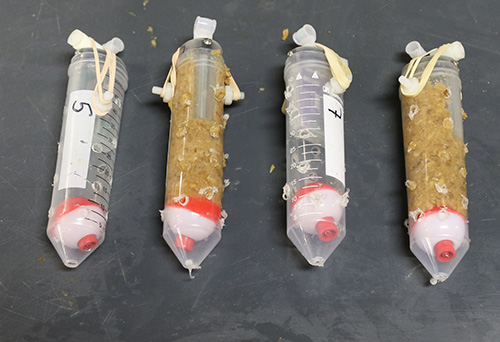
Data loggers, each filled with either alternative bait, or left empty as a control.
Dr. Jury and David Glass worked together on the coast at SMCC to deploy over 40 traps over the summer. After a period of trial and error, they got the traps to a point where they could retrieve successful data from the loggers. Each logger, which was attached to the bottom of the trap so as to float up vertically, with a waterproof accelerometer inside, which sensed interaction between the lobsters and the container containing different kinds of bait. Data was then collected from the loggers in each trail, and analyzed to determine how many lobster interactions had occurred each hour. Bailey Gryskwicz explained that it was her job to take the data from the loggers, calculate what it meant, find successful hits, and track the effectiveness of one bait in comparison to another.
So far, the team has found moderate success— interactions with the green crab bait show that green crab is attractive to lobsters but herring still performs better based on these behavioral experiments. Dr. Jury noted that he does not expect that these baits will replace herring or other fish baits as the predominant lobster baits; however, they may serve to supplement existing bait distribution when sources of traditional bait are limited. The project strives not only to provide another viable option for lobstermen in the face of reduced availability and increased cost of herring, but also to provide additional motivation for the fishing of invasive green crabs.
For Bailey Gryskwicz and David Glass, the support of the Sage foundation and Maine SeaGrant provided extraordinary hands-on experiences in their fields. Glass said that getting to see and experience how an experiment is carried out from start to finish was an invaluable experience for his academic and personal journey. Gryskwicz added that this project has provided valuable experiential qualifications for her grad school applications, helping her to reach her professional goals as she moves on from Saint Joseph’s this spring.
 The research for an alternative lobster bait was funded in part by the John Sage Foundation, a Maine organization which has supported numerous projects conducted by Saint Joseph’s science faculty and students over the years. The support provided in 2019 carries special meaning, as this grant was dedicated by the trustees of the Sage Foundation to the memory of their longtime board member, Jane Hastings Brackett. Jane, who with her family and friends was dedicated to work which sustains a healthy environment, died suddenly last spring. Her family members agree that finding a positive role in the marine ecosystem for an invasive species like the green crab would have touched Jane’s heart. Saint Joseph’s College joins Jane’s husband, Don, her sons, her parents, and her friends in honoring her memory through this work.
The research for an alternative lobster bait was funded in part by the John Sage Foundation, a Maine organization which has supported numerous projects conducted by Saint Joseph’s science faculty and students over the years. The support provided in 2019 carries special meaning, as this grant was dedicated by the trustees of the Sage Foundation to the memory of their longtime board member, Jane Hastings Brackett. Jane, who with her family and friends was dedicated to work which sustains a healthy environment, died suddenly last spring. Her family members agree that finding a positive role in the marine ecosystem for an invasive species like the green crab would have touched Jane’s heart. Saint Joseph’s College joins Jane’s husband, Don, her sons, her parents, and her friends in honoring her memory through this work.
